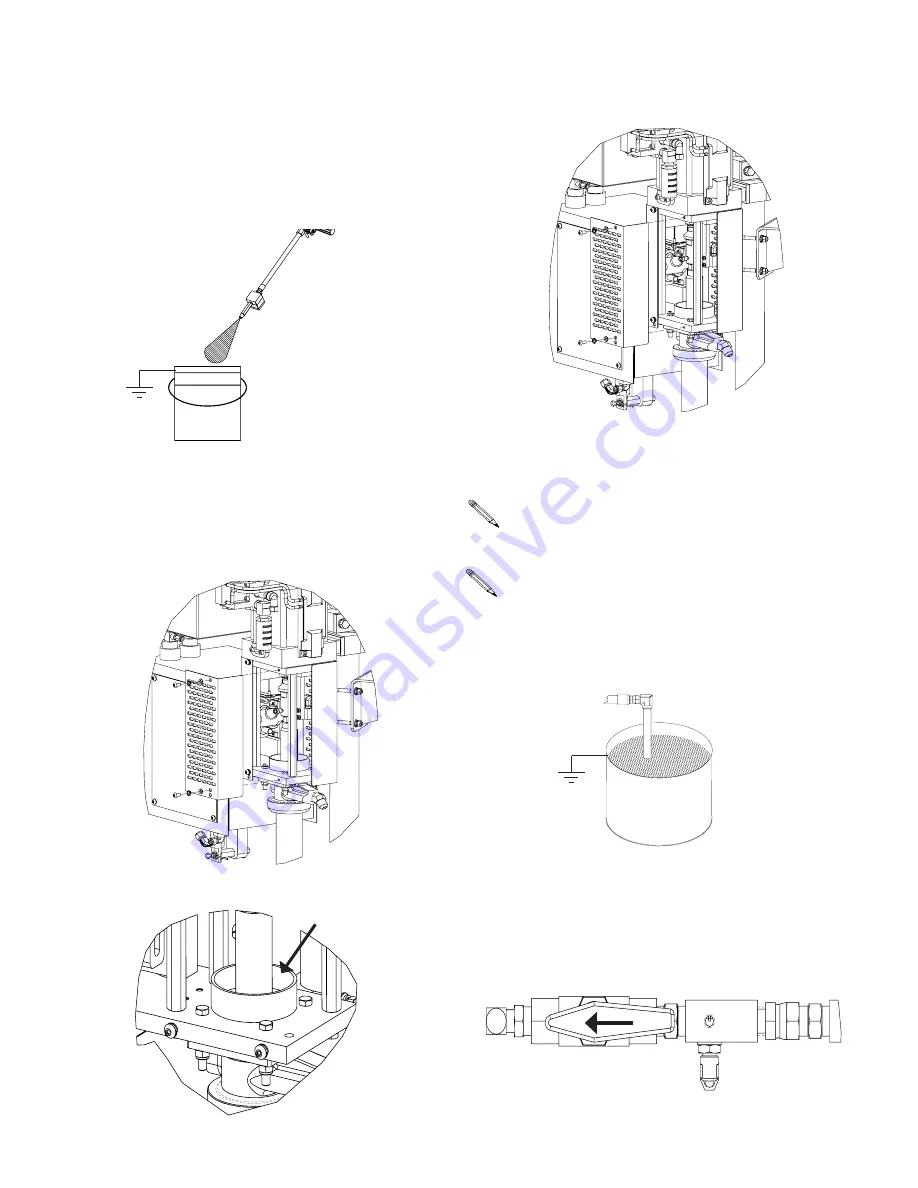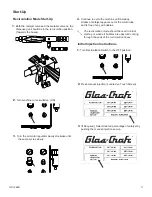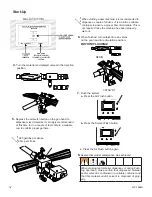
14
GC-1368N
10.
Place injection nozzle over a proper waste con-
tainer. Press the solvent button (located on the
front of the control panel) to assure proper flush.
Press the air flush button (located on the front of
the control panel) to purge any remaining solvent
from the gun head.
11.
Exhaust air through the gun head until traces of
solvent have been dissipated.
Resin Start-Up
1.
Remove yellow guard using a 5/32” hex balldriver.
2.
Fill material pump lube cup with proper pump lube.
3.
Replace yellow guard using a 5/32” hex balldriver.
4.
Before operating the material pump, flush thoroughly
with a clean, suitable solvent to remove test fluid.
GlasCraft uses test fluid that may not be compatible
with some resins. Then, it is recommended that the
test fluid be flushed from the material pump fluid
section.
Make sure hose fittings on the pick-up hoses are tight.
5.
Place the material pick-up tube into a container of
clean, suitable solvent.
6.
Place the recirculation hose into a suitable solvent/
waste container.
7.
Turn main valve on the gun head to the recirculation
position (Towards the hoses).
Start-Up
Isocyanate Conditions
Rev. G 6/17/2008
21
Isocyanate Conditions
Material Self-ignition
Moisture Sensitivity of
Isocyanites
Isocyanites (ISO) are catalysts used in two component
foam and polyurea coatings. ISO will react with moisture
(such as humidity) to form small, hard, abrasive crystals,
which become suspended in the fluid. Eventually a film
will form on the surface and the ISO will begin to gel,
increasing in viscosity. If used, this partially cured ISO
will reduce performance and the life of all wetted parts.
To prevent exposing ISO to moisture:
•
Always use a sealed container with a desiccant
dryer in the vent, or a nitrogen atmosphere.
Never
store ISO in an open container.
•
Keep the ISO lube pump reservoir (if installed) filled
with Graco Throat Seal Liquid (TSL), Part 206995.
The lubricant creates a barrier between the ISO and
the atmosphere.
•
Use moisture-proof hoses specifically designed for
ISO, such as those supplied with your system.
•
Never use reclaimed solvents, which may contain
moisture. Always keep solvent containers closed
when not in use.
•
Never use solvent on one side if it has been contam-
inated from the other side.
•
Always lubricate threaded parts with ISO pump oil
or grease when reassembling.
Keep Components A and
B Separate
Foam Resins with 245 fa
Blowing Agents
Some foam blowing agents will froth at temperatures
above 90°F (33°C) when not under pressure, especially
if agitated. To reduce frothing, minimize preheating in a
circulation system.
Spraying materials containing isocyanates creates
potentially harmful mists, vapors, and atomized partic-
ulates.
Read material manufacturer’s warnings and material
MSDS to know specific hazards and precautions
related to isocyanates.
Prevent inhalation of isocyanate mists, vapors, and
atomized particulates by providing sufficient ventila-
tion in the work area. If sufficient ventilation is not
available, a supplied-air respirator is required for
everyone in the work area.
To prevent contact with isocyanates, appropriate per-
sonal protective equipment, including chemically
impermeable gloves, boots, aprons, and goggles, is
also required for everyone in the work area.
Some materials may become self-igniting if applied
too thickly. Read material manufacturer’s warnings
and material MSDS.
The amount of film formation and rate of crystalli-
zation varies depending on the blend of ISO, the
humidity, and the temperature.
NOTICE
To prevent cross-contamination of the equipment’s
wetted parts,
never
interchange component A (isocy-
anate) and component B (resin) parts.
Isocyanate Conditions
Rev. G 6/17/2008
21
Isocyanate Conditions
Material Self-ignition
Moisture Sensitivity of
Isocyanites
Isocyanites (ISO) are catalysts used in two component
foam and polyurea coatings. ISO will react with moisture
(such as humidity) to form small, hard, abrasive crystals,
which become suspended in the fluid. Eventually a film
will form on the surface and the ISO will begin to gel,
increasing in viscosity. If used, this partially cured ISO
will reduce performance and the life of all wetted parts.
To prevent exposing ISO to moisture:
•
Always use a sealed container with a desiccant
dryer in the vent, or a nitrogen atmosphere.
Never
store ISO in an open container.
•
Keep the ISO lube pump reservoir (if installed) filled
with Graco Throat Seal Liquid (TSL), Part 206995.
The lubricant creates a barrier between the ISO and
the atmosphere.
•
Use moisture-proof hoses specifically designed for
ISO, such as those supplied with your system.
•
Never use reclaimed solvents, which may contain
moisture. Always keep solvent containers closed
when not in use.
•
Never use solvent on one side if it has been contam-
inated from the other side.
•
Always lubricate threaded parts with ISO pump oil
or grease when reassembling.
Keep Components A and
B Separate
Foam Resins with 245 fa
Blowing Agents
Some foam blowing agents will froth at temperatures
above 90°F (33°C) when not under pressure, especially
if agitated. To reduce frothing, minimize preheating in a
circulation system.
Spraying materials containing isocyanates creates
potentially harmful mists, vapors, and atomized partic-
ulates.
Read material manufacturer’s warnings and material
MSDS to know specific hazards and precautions
related to isocyanates.
Prevent inhalation of isocyanate mists, vapors, and
atomized particulates by providing sufficient ventila-
tion in the work area. If sufficient ventilation is not
available, a supplied-air respirator is required for
everyone in the work area.
To prevent contact with isocyanates, appropriate per-
sonal protective equipment, including chemically
impermeable gloves, boots, aprons, and goggles, is
also required for everyone in the work area.
Some materials may become self-igniting if applied
too thickly. Read material manufacturer’s warnings
and material MSDS.
The amount of film formation and rate of crystalli-
zation varies depending on the blend of ISO, the
humidity, and the temperature.
NOTICE
To prevent cross-contamination of the equipment’s
wetted parts,
never
interchange component A (isocy-
anate) and component B (resin) parts.
Содержание Spartan 3
Страница 12: ...12 GC 1368N 4 Push for set up screen Start Up ...
Страница 26: ...26 GC 1368N REVISION A 23280 02 SPARTAN 3 ASSEMBLY 01 Assembly Drawings ...
Страница 27: ...27 GC 1368N REVISION A 23280 02 SPARTAN 3 ASSEMBLY Assembly Drawings ...
Страница 28: ...28 GC 1368N REVISION A 23280 02 SPARTAN 3 ASSEMBLY Assembly Drawings ...
Страница 30: ...30 GC 1368N REVISION J 23250 00 SPARTAN 3 CONTROL BOX ASSEMBLY Sub Assembly Drawings ...
Страница 31: ...31 GC 1368N REVISION J 23250 00 SPARTAN 3 CONTROL BOX ASSEMBLY Sub Assembly Drawings ...
Страница 32: ...32 GC 1368N REVISION J 23250 00 SPARTAN 3 CONTROL BOX ASSEMBLY Sub Assembly Drawings ...
Страница 35: ...35 GC 1368N REVISION J 23250 00 SPARTAN CONTROL BOX SCHEMATIC Sub Assembly Drawings ...
Страница 43: ...43 GC 1368N REVISION P 23280 00 SPARTAN 3 W PAC ASSEMBLY 01 Accessories ...
Страница 44: ...44 GC 1368N REVISION P 23280 00 SPARTAN 3 W PAC ASSEMBLY Accessories ...





























